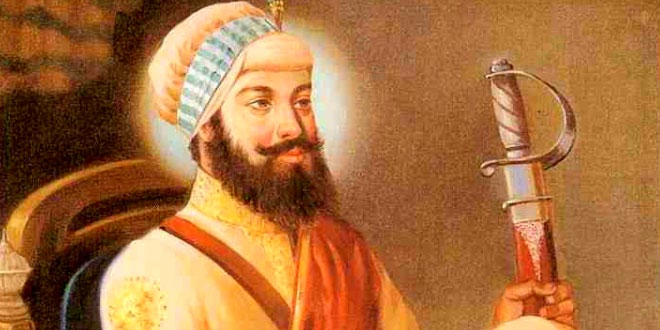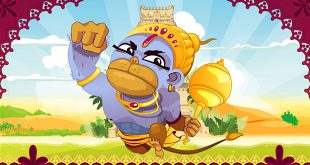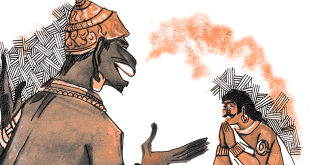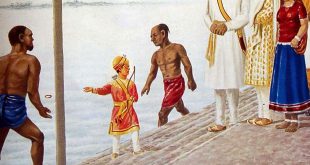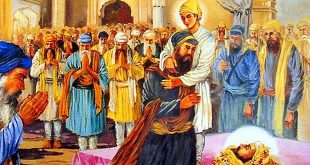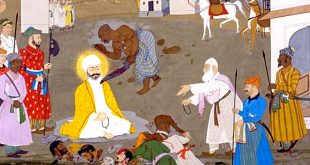Guru Hargobind Singh and his unique leadership of the Sikhs after the brutal execution of Guru Arjan by the Mughal emperor Jahangir. Guru Hargobind Singh was only 11 years old when he was appointed the Guru. The Sikhs were already a community of people who had a culture that was distinct from all others – Sikhs were a community that regarded all humanity as equal, gave women an equal status as men and rejected the vicious caste structures that plagued the Indian society. Under the leadership of Guru Hargobind Singh, Sikhs acquired the skills to defend themselves and the young Sikh faith from the atrocities of the Mughal rulers.
On 14th June 1595, Hargobind, the only son of Guru Arjan was born in the village of Wadali, about 6 miles west of Amritsar. Guru Arjan had started the construction of the Harmandir Sahib in 1588, and embarked on extensively touring the Punjab during this time. Hargobind grew up in and around Amritsar, and Guru Arjan’s philanthropic activities had a lasting impact on him.
Punjab was in the grip of a devastating drought between 1595 and 1598. The drought further led to the spread of diseases and Lahore was one of the worst affected areas. Guru Arjan toured the affected areas and set up camps for treating the people and to provide them with food and shelter.
In 1601, at the age of 6, young Hargobind started his formal education under the guidance of Baba Buddha. Baba Buddha noticed that besides Gurbani, young Hargobind possessed a keen interest in martial arts, and encouraged him to learn the ways of a warrior, which included riding, hunting, wrestling and the use of weapons. Hargobind grew up to be an all-round man, healthy and strong as well as enlightened and knowledgeable in Gurbani.
Guru Hargobind Singh Ji के वंशजों की हवेली के करें दर्शन!
Around this time, the political climate of Punjab was also changing. Although the Mughal emperor Akbar was a tolerant ruler, it was clear that his governors and certain high caste Hindu Brahmins were against the policies of the Sikh Gurus – policies that guaranteed equality of humanity, freedom from oppression and no discrimination on the basis of caste, creed or religion.
Indeed, when Akbar passed away in 1606 and his son Jehangir came to power, the tide turned against the Sikhs. Jehangir had premeditated action against Guru Arjan, and within 7 months of him becoming the new Mughal ruler of India, Jehangir had Guru Arjan executed. Thus at a tender age of 11 years, Guru Hargobind assumed the Guruship of the Sikhs.
The brutal murder of Guru Arjan was a huge shock to the Sikhs. Jehangir’s order to arrest Guru Hargobind and confiscate his property were not carried out, for the local officials believed that the death of the Guru would keep the Sikhs subdued for a long period of time. The result was quite the opposite. The Sikhs rallied around the 11 year old Guru Hargobind, and Bhai Gurdas and Baba Buddha the two veterans of Sikh faith.
Even at such a young age, Guru Hargobind Singh realized that to protect the Sikh faith, it was essential that Sikhs learn the art of self defense. He envisioned that Sikhs from now onwards would be soldiers of the highest order – these trained Sikh soldiers were expected to be brave in standing up to Mughal oppression, but at the same time, never to be the aggressors. This was the foundation of the Saint Soldiers.
At his succession as the 6th Guru, Hargobind wore two swords, one to represent temporal interest or Miri, and the other to represent spiritual interests or Piri. Amritsar was well established as a city of the Sikhs and the Masand system instituted by Guru Ramdas was already functioning well. Guru Hargobind instructed his Masands that in addition to money, food and service, the Guru shall accept horses and weapons as Daswandh, or the voluntary contribution of Sikhs to the Guru’s funds.
These offerings were used to train Sikhs in martial arts. Soon, Sikhs from all across the country poured into Amritsar. The Guru gave each of them a horse and imparted simple training in the use of weapons. In a short time his army swelled up to about 500. These Sikhs did not want any pay. The Guru kept their spirits high by taking them out on hunting expeditions and arranging games and wrestling matches. In addition, the city of Amritsar was fortified by a small fortress called Lohgarh or a castle of Steel.
In 1609, right across from the Harmandar Sahib in Amritsar, Guru Hargobind built the Akal Takht, or the Throne of the Timeless God. Here, besides prayers and preaching, talks were held on questions affecting the welfare of the community. The processes were democratic and major decisions were taken by the consent of the Sikhs. Also, to rouse the morale of the Sikhs, certain Vars, or ballads featuring tales of heroism, composed and set to heroic tunes by Guru Arjan were sung.
Established day of Shri Akal Takht Sahib celebrated with reverence.
In the courtyards of the Harmandir Sahib and Akal Takht, thousands of people could gather and listen to the discourse from Guru Hargobind. All of these programs put a new lease of life into the hearts of the Sikhs, who had been dejected at the brutal murder of Guru Arjan. In addition, thousands of more people came into the folds of Sikhism, leaving behind the oppressive social structures of both the Hindus and the Muslims.
Jehangir was occupied with his internal affairs in Kabul and later in Gujarat up to about 1618. So he had little time to interfere in the political environment of the Punjab. This gave the Sikhs a period of time to organize themselves in preparation for what they thought was an inevitable skirmish with the Mughal rulers again.
In 1613, Baba Gurditta, the eldest son of Guru Hargobind and his wife Damodari was born. He was followed by Bibi Viro in 1615, Suraj Mal in 1617, Ani Rai in 1618, Atal Rai in 1619 and Teg Bahadur who went on to become the 9th Sikh Guru in 1621.
During all these years, Guru Hargobind engaged himself in the work of preaching the message of the previous Sikh Gurus. After Guru Nanak, he was the first Sikh Guru to travel outside the Punjab. He went as far as Kashmir in the North and to Pilibhit, about 200 miles to the East of Delhi. His message of Ek-Onkar resonated well everywhere he went and thousands of people embraced Sikhism, for it emancipated them from the rigid and oppressive social order.
In about 1620, Jehangir made a trip from Lahore to Agra – the trip lasted 70 days and 23 of those days were spent on a short stretch along the river Beas in Punjab. On this trip he learned first hand that all of Punjab was aligned with the Sikh ideology and thought. Alarmed by these observations, in about March 1621, Jehangir ordered that Guru Hargobind be imprisoned in a jail at the Gwalior Fort – this Jail was reserved for royals and prominent religious figures who had fallen out of favor with Jehangir. In total there were 52 other prisoners at the Gwalior fort. During the Guru’s imprisonment Sikhs from all over the country came to Gwalior to pay their respects to Guru Hargobind. However, owing to the large and growing Sikh population, as well as a few well intention Muslims, Jehangir feared a revolt in the local population, who were still agonized by the unjust execution of Guru Arjan.
As a result, only after 4 months of captivity Guru Hargobind Singh was ordered to be released. Guru Hargobind refused to leave the Gwalior fort alone and advocated for the release of the 52 other princes in captivity. For this reason, he is also known as BandiChhor – or the one who freed the convicts. Prof. Sahib Singh further asserts that while Guru Hargobind was on his way back to Amritsar, he was accompanied by Jehangir, who, separately was on the way to Kashmir. Several other sources also state that Jehangir, realized that he had been misled in handling the case of Guru Arjan. As a result, he wanted to befriend the Guru or at least maintain normal relations thereafter. It must be noted that in his autobiography Tuzuk-i-Jehangiri, Jehangir does not mention anything about Guru Hargobind.
On his successful return to Amritsar, the Raja of Bilaspur gave Guru Hargobind a gift of land between the foothills of the Himalayas and the river Sutlej. Here, he built himself a retreat and named the town Kiratpur, which is now situated about 125 miles east of Amritsar. Also, Guru Hargobind resumed his travel and preaching across the country. Wherever Guru Hargobind went he established Gurudwaras – in addition, he also erected temples and mosques at his own expense.
Guru Hargobind was not allowed to live long in peace. Jehangir had turned into a drunkard and died in 1627. He was succeeded by his son Shah Jahan, the Mughal emperor famous for building the Taj Mahal, and then cutting off the hands of more than 20,000 people who worked on the monument. Shah Jahan revived the policy of oppression against non-Muslims and ordered the demolition of numerous Gurdwaras. This brought him into direct conflict with the Sikhs, who after the execution of Guru Arjan and imprisonment of Guru Hargobind were now determined to fight back. Both parties were primed for a clash at the slightest cause.
Shah Jahan’s empire spanned from Kabul and Kandahar, now in Afghanistan, to almost all of present day India and Pakistan. In 1628, during one of his hunting trips to Lahore, Shah Jahan ran into the Sikhs which led to a minor skirmish. As a result, Shah Jehan sent his governor, Mukhlis Khan to arrest the Guru. This was now the beginning of the wars between the Sikhs and the Mughals.
The Mughals attacked Lohgarh, the fortress surrounding Amritsar. This was a sudden and unexpected development. Guru Hargobind was already busy in the wedding preparations for his daughter Bibi Viro the next day. The Sikhs were reluctantly thrust into their first war and they fought bravely killing Mukhlis Khan. Victorious and to avoid any further skirmish, Guru Hargobind retreated to a small village Jhabal, eight miles from Amritsar, where he was able to perform the marriage of his daughter.
To avoid any further trouble, Guru Hargobind retreated to Kartarpur, near Jalandhar. However, in 1630, on the provocation of Bhagwan Dass and his son Rattan Chand, another skirmish ensued between the Mughals and the Sikhs. After 3 days of hard fighting, Abdulla Khan, the governor of Jalandhar was killed and the Sikhs emerged victorious again.
Then in 1632, Guru Hargobind’s Sikhs were attacked by a powerful army led by Lalla Beg and Qamar Beg. A fierce battle ensued in the neighborhood of the villages of Mehraj and Nathana, close to present day Bhatinda. More than 1200 Sikhs were wounded or killed, whereas many more, including the Mughal commanders Lalla and Qamar Beg were killed, leaving the Sikhs victorious in another fight.
After about another year, the Mughals regrouped, this time under the instigation of Painda Khan – once a loyal of the Guru. The Guru’s forces were encircled in Kartarpur, but were once again able to turn the tables on the Mughals. Fighting along with other Sikhs were Guru Hargobind’s two sons, Baba Gurditta and Teg Bahadur. The Imperial army was again routed and the renegade Painda Khan was killed.
Guru Hargobind had won 4 battles with the Mughals. His purpose was always defensive and as a result he did not acquire even a small piece of territory in these victories. There was something far greater involved in this warfare – A new heroism was rising in the Punjab, and the main aim was to create a will to resist the mighty power of the oppressive Mughal rulers.
After 4 battles in quick succession, Guru Hargobind realized that he could not withstand another battle with the Mughals in the plains. In 1634, he shifted his base to Kiratpur, a city he had built previously along the foothills of the Himalayas. He spent the last 10 years of his life at Kiratpur in meditation and in prayer. One drawback of all these battles was that the Sikhs had to retreat away from Amritsar, and subsequently the Minas, or the descendants of Prithi Chand, occupied the Harmandir Sahib and it remained under their control for the next 60 years. The Minas played havoc with the Sikh ideology and introduced a lot of mythology into the teachings of Guru Nanak and other Sikh gurus.
The influx of superstition from the Minas placed a great deal of burden on Guru Hargobind. He had to set up many more community centers and train more masands. In the earlier years, this work was taken up by Bhai Gurdas and Baba Buddha, and after the death of these men, by Baba Gurditta. Guru Hargobind entrusted more and more responsibility to Baba Gurditta, whom, it appears, he was training for Guruship.
The last few years of Guru Hargobind’s life were saddened by a series of personal tragedies. Within a few years 3 of his sons died after one another, including Baba Gurditta in 1638. One of Gurditta’s sons, Dhir Mal turned against the Guru. Finally, he chose Gurditta’s second son Har Rai to succeed him as the 7th Sikh guru. Guru Hargobind died peacefully in Kiratpur on March 3, 1644 at the age of 48.
The 37 years of Guru Hargobind Singh’s Guruship, were by far the most testing in the history of the Sikhs. These years tested the resolve of the community to stay together in adversity – and the Sikhs passed this test with flying colors. Their resolve to remain united was strengthened. Under the leadership of Guru Hargobind, the Sikh emphasis changed from a peaceful propagation of the teachings of the Sikh gurus to the forthright declaration of the right to defend their faith by arms. Guru Hargobind Singh infused in the Sikhs the confidence that they could challenge the might of the Mughals and stand up against oppression. Although he infused his followers with a passion to defend their Sikh faith with a call to arms, Guru Hargobind Singh was himself an extremely compassionate person, working for the welfare of all humanity. Although he did not compose any hymns, Guru Hargobind taught his Sikhs by way of example that the service of the poor and the oppressed is the service of God. In 1608, Guru Hargobind built the Akal Takht at Amritsar thereby uniting the Sikhs as a single political and spiritual entity.
 Kids Portal For Parents India Kids Network
Kids Portal For Parents India Kids Network
